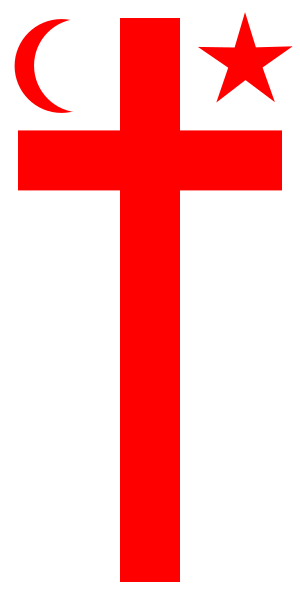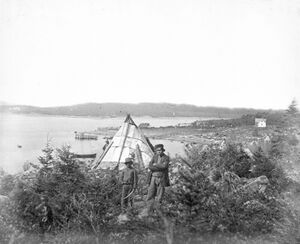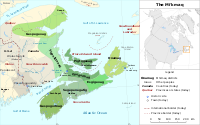ميكماك
Lnu | |
|---|---|
 Grand Council Flag of the Miꞌkmaq Nation.[1] Although the flag is meant to be displayed hanging vertically as shown here, it is quite commonly flown horizontally, with the star near the upper hoist. | |
 A Miꞌkmaw father and child at Tufts Cove, Nova Scotia, around 1871 | |
| إجمالي التعداد | |
| 168,480 (2016 census)[2] | |
| المناطق ذات التجمعات المعتبرة | |
| (Mi'kma'ki, Dawnland) Canada, United States (Maine) | |
| Newfoundland and Labrador | 36,470 |
| Nova Scotia | 34,130 |
| Ontario | 32,095 |
| Quebec | 25,230 |
| New Brunswick | 18,525 |
| British Columbia | 6,410 |
| Prince Edward Island | 2,330 |
| اللغات | |
| English, Miꞌkmaq, French | |
| الدين | |
| Miꞌkmaq traditionalism and spirituality, Christianity, others | |
| الجماعات العرقية ذات الصلة | |
| Algonquian people, Abenaki, Beothuk, Maliseet, Passamaquoddy, Penobscot | |
الميكماك (بالإنگليزية Micmac أو Mìgmaq أو Mi'gmaq) هم من قبال السكان الأصليين لشمالي أمريكا. استوطنوا مناطق نيو إنگلند، مقاطعات كندا الأطلسية وهضبة گاسبي في الكيبيك. عددهم 40 الف نسمة وثلثهم يتكلمون لغة ألگونكوين المعروفة بالنيوسيمك والتي كانت تستعمل الكلمات التصويرية.
Miꞌkmaq (also Mi'gmaq, Lnu, Miꞌkmaw or Miꞌgmaw; English: /ˈmɪɡmɑː/; Miꞌkmaq: [miːɡmaɣ])[3][4][5] are a First Nations people of the Northeastern Woodlands, indigenous to the areas now known as Canada's Atlantic Provinces and the Gaspé Peninsula of Quebec as well as the northeastern region of Maine. They call their national territory Miꞌkmaꞌki (or Miꞌgmaꞌgi). The nation has a population of about 170,000 (including 18,044 members in the recently formed Qalipu First Nation in Newfoundland[6][7]), of whom nearly 11,000 speak Miꞌkmaq, an Eastern Algonquian language.[8][9] Once written in Miꞌkmaw hieroglyphic writing, it is now written using most letters of the Latin alphabet.
The Mi'kmaq, Maliseet, and Pasamaquoddy nations, whose traditional lands are in the Atlantic region of what is now Canada, signed a series of treaties known as the Covenant Chain of Peace and Friendship Treaties with the British Crown throughout the eighteenth century; the first was signed in 1725, and the last in 1779. They did not cede or give up their land title or other rights through these Peace and Friendship Treaties.[10] The landmark 1999 Supreme Court of Canada decision in R v Marshall upheld the 1752 Peace and Friendship Treaty "which promised Indigenous Peoples the right to hunt and fish their lands and establish trade."[11]
The Miꞌkmaw Grand Council is the official authority that engages in consultation with the Canadian federal government and the provincial government of Nova Scotia, as established by the historic August 30, 2010 agreement with the Miꞌkmaq Nation, resulting from the Miꞌkmaq–Nova Scotia–Canada Tripartite Forum.[12] This collaborative agreement, which includes all the First Nations within the province of Nova Scotia, was the first in Canadian history.[12] Historically the Santé Mawiómi, or Grand Council, which was made up of chiefs of the district councils of Miꞌkmaꞌki, was the traditional senior level of government for the Miꞌkmaw people. The 1876 Indian Act disrupted that authority, by requiring First Nations to establish representative elected governments and attempting to limit the Council's role to spiritual guidance.[13][14]
Grand Council Santé Mawiómi
Miꞌkmaq language
Hieroglyphic writing
The Mi'kmaq language was written using Miꞌkmaq hieroglyphic writing. Today it is written mainly using letters of the Latin alphabet.
الجغرافيا

Miꞌkmaw Country, known as Miꞌkmaꞌki, is traditionally divided into seven districts. Prior to the imposition of the Indian Act, each district had its own independent government and boundaries. The independent governments had a district chief and a council. The council members were band chiefs, elders, and other worthy community leaders. The district council was charged with performing all the duties of any independent and free government by enacting laws, justice, apportioning fishing and hunting grounds, making war and suing for peace.
المقاطعات
The eight Miꞌkmaw districts (including Ktaqmkuk which is often not counted) are Epekwitk aq Piktuk (Epegwitg aq Pigtug), Eskikewaꞌkik (Esgeꞌgewaꞌgi), Kespek (Gespeꞌgewaꞌgi), Kespukwitk (Gespugwitg), Siknikt (Signigtewaꞌgi), Sipekniꞌkatik (Sugapuneꞌgati), Ktaqmkuk (Gtaqamg), and Unamaꞌkik (Unamaꞌgi). The orthography between parentheses is the Listuguj orthography used in the Gespeꞌgewaꞌgi area.
العلاقات الفدرالية والمقاطعية مع ميكماك
Dispute over rights-based inshore lobster fishery (2020–present)
| Dispute over rights-based inshore lobster fishery | |||
|---|---|---|---|
| التاريخ | September 2020 - ongoing | ||
| المكان | |||
| السبب | Miꞌkmaq exercising their treaty rights to fish | ||
| الوضع | ongoing | ||
| أطراف الصراع الأهلي | |||
| |||
| الخسائر | |||
| المتهمون | 23 | ||
Gabriel Sylliboy was the first Miꞌkmaw elected as grand chief in 1919 and the first to fight for treaty recognition - specifically, the Treaty of 1752 - in the Supreme Court of Nova Scotia.
Gallery of images from the 19th century
Grand Chief Jacques-Pierre Peminuit Paul (3rd from left with beard) meets Governor General of Canada, Marquess of Lorne, Red Chamber, Province House, Halifax, Nova Scotia, 1879.[16]
Miꞌkmaq at Turtle Grove (Tufts Cove) settlement, Dartmouth, Nova Scotia, ca. 1871.
First Nation subdivisions
Miꞌkmaw names in the following table are spelled according to several orthographies. The Miꞌkmaw orthographies in use are Miꞌkmaw pictographs, the orthography of Silas Tertius Rand, the Pacifique orthography, and the most recent Smith-Francis orthography. The latter has been adopted throughout Nova Scotia and in most Miꞌkmaw communities.
الديمغرافيا
| السنة | التعداد | التحقق |
|---|---|---|
| 1500 | 4,500 | تقدير |
| 1600 | 3,000 | تقدير |
| 1700 | 2,000 | تقدير |
| 1750 | 3,000[19] | Estimation |
| 1800 | 3,100 | Estimation |
| 1900 | 4,000 | Census |
| 1940 | 5,000 | Census |
| 1960 | 6,000 | Census |
| 1972 | 10,000 | Census |
| 1998 | 15,000 | SIL |
| 2006 | 20,000 | Census |
The pre-contact population is estimated at 3,000–30,000.[20] In 1616, Father Biard believed the Miꞌkmaw population to be in excess of 3,000, but he remarked that, because of European diseases, there had been large population losses during the 16th century. Smallpox and other endemic European infectious diseases, to which the Miꞌkmaq had no immunity, wars and alcoholism led to a further decline of the native population. It reached its lowest point in the middle of the 17th century. Then the numbers grew slightly again, before becoming apparently stable during the 19th century. During the 20th century, the population was on the rise again. The average growth from 1965 to 1970 was about 2.5%.
Maps
Maps showing the approximate locations of areas occupied by members of the Wabanaki Confederacy (from north to south):
Eastern Abenaki (Penobscot, Kennebec, Arosaguntacook, Pigwacket/Pequawket
Western Abenaki (Arsigantegok, Missisquoi, Cowasuck, Sokoki, Pennacook
See also
- Algonquian peoples
- List of Grand Chiefs
- Military history of Nova Scotia
- Silas Tertius Rand
- Tarrantine
- Qalipu Miꞌkmaq First Nation Band
Notes
References
- ^ "Flags of the World". Archived from the original on 2017-07-04. Retrieved 2009-11-20.
- ^ "Aboriginal Ancestry Responses (73)". www12.statcan.gc.ca (in الإنجليزية). Government of Canada. 2017-10-25. Retrieved 2017-11-23.
- ^ "Native Languages of the Americas: Mi'kmaq Language (Mi'kmaw, Micmac, Mikmaq, Mikmak)". Native-Languages.org. Retrieved October 31, 2018.
- ^ Lockerby, Earle (2004). "Ancient Miꞌkmaq Customs: A Shaman's Revelations" (PDF). The Canadian Journal of Native Studies. 24 (2): 403–423. see page 418, note 2
- ^ Sock, S., & Paul-Gould, S. (2011). Best Practices and Challenges in Miꞌkmaq and Maliseet/Wolastoqi Language Immersion Programs.
- ^ أ ب "Programs and Services". Qalipu.ca.
- ^ "Thousands of Qalipu Miꞌkmaq applicants rejected again", CBC, Dec 08, 2017.
- ^ "Table 1: Indigenous Languages Spoken in the United States (by Language)". YourDictionary.
- ^ contenu, English name of the content author / Nom en anglais de l'auteur du. "English title / Titre en anglais". www12.statcan.ca.
{{cite web}}:|first=has generic name (help) - ^ Bernard, Tim; Rosenmeier, Leah Morine; Farrell, Sharon L., eds. (2015). Mi'kmawe'l Tan Teli-kina'muemk Teaching About the Mi'kmaq (PDF). The Mi’kmawey Debert Cultural Centre. p. 106.
- ^ خطأ استشهاد: وسم
<ref>غير صحيح؛ لا نص تم توفيره للمراجع المسماةCBC_Bunsale_20201018 - ^ أ ب خطأ استشهاد: وسم
<ref>غير صحيح؛ لا نص تم توفيره للمراجع المسماةTripartiteForum1997 - ^ Julien, Donald M. (October 2007). Kekina'muek (learning)Learning about the Mi'kmaq of Nova Scotia (PDF). Eastern Woodland Print Communication. p. 11. Retrieved 21 February 2020.
- ^ "Mi'kmaq Historical Overview". Cape Breton University. Retrieved 21 February 2020.
- ^ Jeddore, John Nick (August 25, 2011). "There were no Indians here ..." TheIndependent.ca.
- ^ "Explore the Royal Collection Online". www.rct.uk.
- ^ "Government of Canada Announces the Creation of the Qalipu First Nation Band' by Marketwire". Retrieved Jul 31, 2020.
- ^ "Press Release September 26, 2011". Archived from the original on July 26, 2012. Retrieved Jul 31, 2020.
- ^ Massachusetts Historical Society; John Davis Batchelder Collection (Library of Congress) (8 June 1792). Collections of the Massachusetts Historical Society. Boston : The Society – via Internet Archive.
- ^ "Micmac". www.dickshovel.com.
Further reading
- Davis, Stephen A. (1998). Míkmaq: Peoples of the Maritimes. Nimbus Publishing.
- Joe, Rita; Choyce, Lesley (2005). The Míkmaq Anthology. Nimbus Publishing. ISBN 1-895900-04-2.
- Johnston, A.J.B.; Francis, Jesse (2013). Niꞌn na L'nu: The Miꞌkmaq of Prince Edward Island. Charlottetown: Acorn Press. ISBN 978-1-894838-93-1.
- Magocsi, Paul Robert, ed. (1999). Encyclopedia of Canada's Peoples. Toronto: University of Toronto Press.
- Prins, Harald E. L. (1996). The Míkmaq: Resistance, Accommodation, and Cultural Survival. Case Studies in Cultural Anthropology. Wadsworth.
- Speck, Frank (1922). Beothuk and Micmac.
- Whitehead, Ruth Holmes (2004). The Old Man Told Us: Excerpts from Míkmaq History 1500-1950. Nimbus Publishing. ISBN 0-921054-83-1.
Archival primary references
In chronological order
- 1749 A Geographic History of Nova Scotia. 1749
- 1758 Malliard, Antoine Simon (1758). An account of the customs and manners of the MicMakis and Marichetts Savage Nations.
- 1760 Thomas Picheon
- 1797 Miꞌkmaq Language, 1797
- 1814 Bromley, Walter (1814). Mr. Bromley's second address, on the deplorable state of the Indians delivered in the "Royal Acadian School," at Halifax, in Nova Scotia, March 8, 1814. [Halifax, N.S.?] : Printed at the Recorder Office. ISBN 9780665209987.
- 1822 Bromley, Walter (1822). An account of the aborigines of Nova Scotia called the Micmac Indians. London? : s.n. ISBN 9780665573224.
- 1819 Rand, Silas Tertius (1850). A short statement of facts relating to the history, manners, customs, language, and literature of the Micmac tribe of Indians, in Nova-Scotia and P.E. Island: being the substance of two lectures delivered in Halifax, in November, 1819, at public meetings held for the purpose of instituting a mission to that tribe. Halifax, N.S.? : s.n. ISBN 9780665395062.
- 1866 Vetromile, Eugene (1866). The Abnakis and their history: Historical notices on the aborigines of Acadia. New York : J.B. Kirker. ISBN 9780665339240.
- 1873 An account of the present state of Nova Scotia Hollingsworth. 1873
- Thomas Pichon on Miꞌkmaq
- 1896 Piers, Harry (1896). Relics of the stone age in Nova Scotia. S.l. : s.n. ISBN 9780665353376.
- Rand and the Micmacs
- 1922 Speck, Frank (1922). Beothuk and Micmac.
Documentary film
- Our Lives in Our Hands (Míkmaq basketmakers and potato diggers in northern Maine, 1986) [1]
- British Radio Documentary on the Miꞌkmaq Community at Millbrook nr Truro Recorded by Terry Mechan June 2012 [2]
External links
- Qalipu First Nation
- Benoit First Nation
- Bras D'Or First Nation
- Bras d'Or - Pitawpoꞌq, Indian name; Little Bras d'Or - Panuꞌskek, Indian name
- Micmac History
- Míkmaq Portraits Collection
- Miꞌkmaq Language. Mass Historical Society
- Míkmaq Dictionary Online
- The Micmac of Megumaagee
- Míkmaq Learning Resource
 [[wikisource:Catholic Encyclopedia (1913)/Micmacs "|Micmacs]"]. Catholic Encyclopedia. New York: Robert Appleton Company. 1913.
[[wikisource:Catholic Encyclopedia (1913)/Micmacs "|Micmacs]"]. Catholic Encyclopedia. New York: Robert Appleton Company. 1913. {{cite encyclopedia}}: Check|url=value (help)- Unamaꞌki Institute of Natural Resources
- Miꞌkmaw Native Friendship Centre
- CS1 errors: generic name
- CS1: Julian–Gregorian uncertainty
- Short description is different from Wikidata
- "Related ethnic groups" needing confirmation
- Articles using infobox ethnic group with image parameters
- Articles with hatnote templates targeting a nonexistent page
- CS1 errors: URL
- Mi'kmaq
- Algonquian ethnonyms
- Algonquian peoples
- First Nations in Atlantic Canada
- First Nations in Quebec
- History of Nova Scotia
- Indigenous peoples of the Northeastern Woodlands
- Native American history of Maine
- Native American tribes in Maine
- Wabanaki Confederacy
- Ethnic groups in Canada
- Ethnic groups in Newfoundland and Labrador
- عرقيات أمريكا
- عرقيات كندا
- عرقيات الولايات المتحدة
- جماعات عرقية

![Grand Chief Jacques-Pierre Peminuit Paul (3rd from left with beard) meets Governor General of Canada, Marquess of Lorne, Red Chamber, Province House, Halifax, Nova Scotia, 1879.[16]](/w/images/thumb/f/f0/Mik%27maq_at_Province_House%2C_Halifax%2CNS_1879.png/120px-Mik%27maq_at_Province_House%2C_Halifax%2CNS_1879.png)






